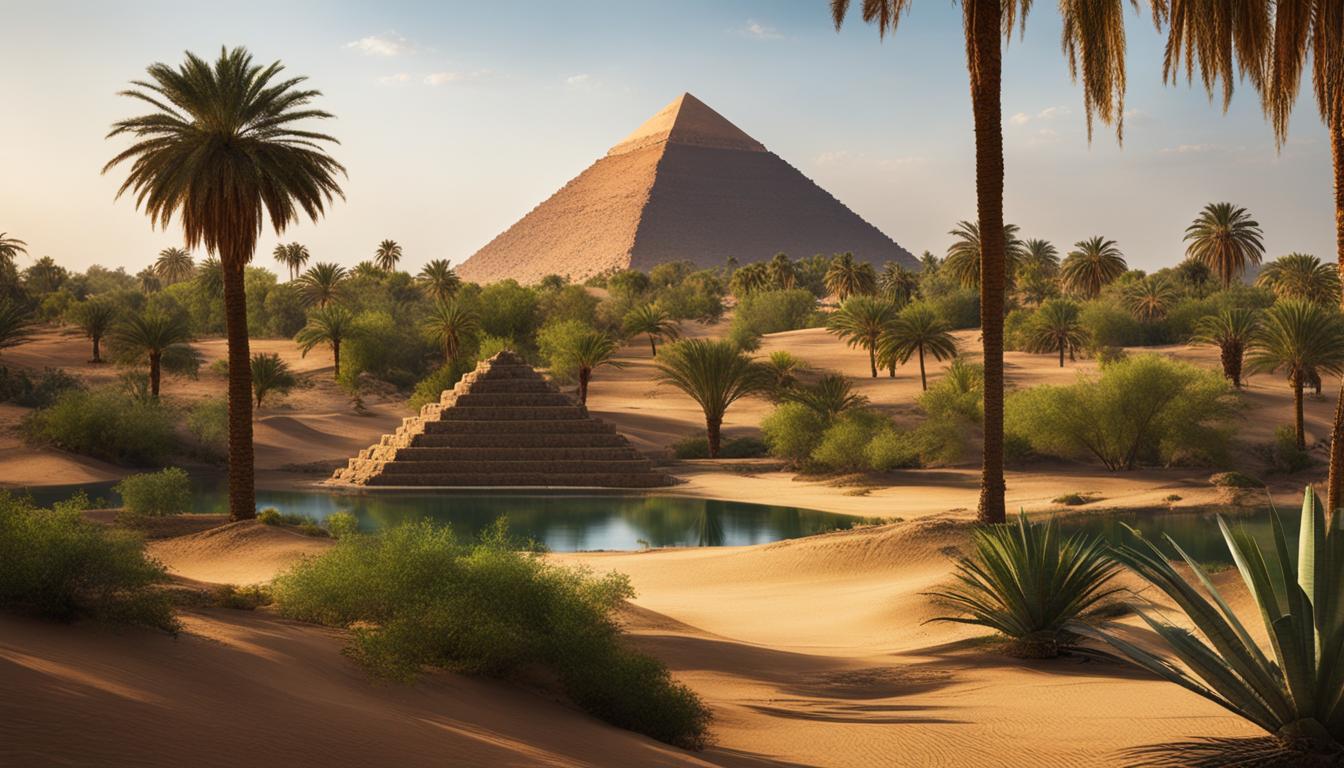Mount Sinai, also known as Mount Horeb, is a significant location in the Bible with deep-rooted religious and historical significance. It is the mountain where Moses received the Ten Commandments from God, according to the Book of Exodus. This sacred site holds great importance in Judaism, Christianity, and Islam as a symbol of divine revelation and the establishment of a covenant between God and his people.
The exact location of Mount Sinai remains debated, although it is generally believed to be situated in the Sinai Desert, between the Gulf of Suez and the Gulf of Aqaba. Despite the ongoing discussion, the significance of Mount Sinai in the Bible is unquestionable, as it represents the place where God revealed Himself and gave the Israelites His laws.
Key Takeaways:
- Mount Sinai is the mountain where Moses received the Ten Commandments from God in the Bible.
- It holds immense religious and historical significance in Judaism, Christianity, and Islam.
- The exact location of Mount Sinai is still a subject of debate.
- Mount Sinai represents divine revelation and the establishment of a covenant between God and His people.
- It serves as a reminder of the importance of God’s laws and teachings.
The Biblical Account of Mount Sinai
According to the biblical account, the Israelites arrived at Mount Sinai after their exodus from Egypt. It is on this mountain that God spoke to Moses and gave him the Ten Commandments, as well as other instructions and teachings for the Israelites. The mountain was enveloped in a cloud and filled with smoke, and there were thunder, lightning, and the sound of a trumpet. The biblical description of the events at Mount Sinai suggests a divine theophany, where God’s presence was tangibly experienced by the people. The mountain became a symbol of the covenant between God and the Israelites, and the giving of the law.
Location of Mount Sinai
The location of Mount Sinai, as described in the Bible, has been a subject of ongoing debate among scholars. While some argue for locations in Saudi Arabia, such as Mount Serbal, or in Egypt, like Mount Catherine in the Sinai Peninsula, there is no definitive consensus. Modern archaeological findings have suggested Har Karkom in the southern Negev as a possible location. However, the general agreement is that Mount Sinai is situated in the Sinai Desert region, between the Gulf of Suez and the Gulf of Aqaba.
Despite the lack of definitive evidence, the historical and cultural significance of Mount Sinai remains intact. Its connection to the biblical narrative and the events that transpired there continue to captivate the imagination of people around the world.

Current Theories on the Location of Mount Sinai
Several theories have emerged regarding the exact location of Mount Sinai. Let’s explore some of the prominent ones:
- Mount Serbal, Egypt: Some scholars argue that Mount Serbal, located in the southern part of the Sinai Peninsula, is the Biblical Mount Sinai. They believe that its distinctive peak and surrounding landscape align with the geographical descriptions found in the Bible.
- Mount Catherine, Egypt: Another popular theory places Mount Sinai at Mount Catherine, the highest peak in the Sinai Peninsula. This theory is supported by the presence of a well-established religious site and monastery dedicated to Saint Catherine at the mountain’s base.
- Har Karkom, Negev, Israel: Har Karkom, located in the southern Negev Desert in Israel, has also been proposed as a possible location for Mount Sinai. Archaeological research has uncovered evidence of ancient occupation and religious activities, suggesting its significance in ancient times.
- Other Locations: There are various other theories proposing alternative locations for Mount Sinai, including locations in Saudi Arabia and Jordan. These theories often draw upon historical and biblical references to support their claims.
While these theories offer intriguing possibilities, the exact location of Mount Sinai remains a mystery. Nevertheless, the ongoing quest to discover its true whereabouts underscores the enduring fascination and importance of this sacred mountain.
Significance of Mount Sinai in the Bible
Mount Sinai holds immense significance in the Bible. It is the sacred location where God established a covenant with the Israelites and bestowed upon them the law, including the Ten Commandments. This mountain served as a holy place where the Israelites had direct encounters with God, experiencing His divine presence and receiving His teachings.
Mount Sinai became a symbol of God’s covenant and the establishment of the Israelite nation. It signified the close relationship between God and His chosen people, emphasizing the importance of obedience and faithfulness to the law. The mountain played a vital role in shaping the religious traditions and beliefs of Judaism, Christianity, and Islam.
The significance of Mount Sinai extends beyond the Old Testament. In the New Testament, Mount Sinai is referred to in connection with the teachings and mission of Jesus, highlighting its enduring relevance in both the Jewish and Christian faiths.
Mt. Sinai is revered by adherents of these religious traditions as a place of great spiritual and historical importance. Its significance lies not only in its physical location but also in the profound impact it had on the religious and cultural development of these faiths.
Comparing the Significance of Mount Sinai in Religious Traditions
| Religious Tradition | Significance of Mount Sinai |
|---|---|
| Judaism | The place where God made a covenant with the Israelites and gave them the Torah and Ten Commandments. Represents divine revelation and the importance of the law. |
| Christianity | Associated with the establishment of the Old Covenant and the teachings of Jesus. Symbolizes divine revelation, the importance of the law, and the fulfillment of the law through love and grace. |
| Islam | Considered a sacred mountain associated with the prophet Moses and divine revelations. Symbolizes the importance of obedience to God’s commandments and the guidance of prophets. |

Mount Sinai in Jewish Tradition
Mount Sinai holds a central role in Jewish tradition. It is considered one of the most sacred mountains in Judaism. According to Jewish belief, it is the place where God made a covenant with the Jewish people and gave them the Torah, including the Ten Commandments. The mountain is often associated with divine revelation and represents the importance of the law in Jewish religious practice. Mount Sinai is mentioned multiple times in the Hebrew Bible and is referenced in various Jewish rituals, prayers, and traditions.
Significance of Mount Sinai in Jewish Tradition
Mount Sinai, known as Har Sinai in Hebrew, has profound significance in Jewish tradition. As the mountain where God granted the Torah to the Israelites, Mount Sinai symbolizes the divine covenant between God and the Jewish people. The Ten Commandments and the rest of the Torah were received by Moses on this sacred mountain, establishing the foundation of Jewish religious law and practice.
“And Mount Sinai was altogether in smoke, because the Lord descended upon it in fire; and the smoke thereof ascended as the smoke of a furnace, and the whole mount quaked greatly.” – Exodus 19:18
Jewish tradition holds Mount Sinai in the highest regard, recognizing it as the location where the Jewish people entered into a sacred covenant with God. The mountain’s significance is reflected in Jewish rituals and observances, such as the Festival of Shavuot, which commemorates the giving of the Torah. During this festival, Jews engage in Torah study and recommit themselves to following God’s commandments.
Mount Sinai in Jewish Tradition
| Aspect | Significance |
|---|---|
| Divine Revelation | Mount Sinai is associated with the direct communication between God and Moses, wherein the Torah was given to the Jewish people. |
| Covenant | The mountain serves as a powerful symbol of the covenant between God and the Jewish people, representing their special relationship. |
| Religious Law | The giving of the Torah on Mount Sinai establishes the foundation of Jewish religious law and is central to Jewish practice. |
| Rituals & Prayers | Mount Sinai is referenced in various Jewish rituals and prayers, emphasizing its ongoing significance in Jewish religious life. |

Mount Sinai in Christian Tradition
Mount Sinai holds great significance in Christian tradition as the sacred mountain where God gave the law to Moses and the Israelites. This pivotal event is associated with the establishment of the Old Covenant between God and His chosen people. In Christianity, Mount Sinai serves as a symbol of divine revelation and the importance of God’s commandments in guiding human behavior.
Central to the Christian faith is the acknowledgment of the Ten Commandments, which were revealed on Mount Sinai. These commandments, given by God to Moses, outline moral principles that form the foundation of Christian ethics and behavior. Jesus himself affirmed the significance of the law when he said, “Do not think that I have come to abolish the Law or the Prophets; I have not come to abolish them but to fulfill them” (Matthew 5:17, New International Version).
In Christianity, the teachings of Jesus extend beyond a strict adherence to the law. While emphasizing the importance of obedience, Jesus also emphasized the need for love and grace. He summarized the commandments by saying, “Love the Lord your God with all your heart and with all your soul and with all your mind… Love your neighbor as yourself” (Matthew 22:37-39, NIV).
“The law of the Lord is perfect, refreshing the soul… The precepts of the Lord are right, giving joy to the heart. The commands of the Lord are radiant, giving light to the eyes.” – Psalm 19:7-8, NIV
Mount Sinai is referenced in various passages throughout the Bible, further reinforcing its spiritual and symbolic importance in Christian tradition. It serves as a tangible reminder of the divine-human relationship, the significance of God’s commandments, and the need for both obedience and grace in the Christian walk.

The Ten Commandments
The Ten Commandments, revealed on Mount Sinai, are foundational to Christian belief and practice. These commandments encompass principles of love, respect, and reverence for God and others. They provide guidance for living a righteous life and maintaining a healthy relationship with God. The Ten Commandments are:
- You shall have no other gods before Me.
- You shall not make for yourself an idol or worship any other gods.
- You shall not misuse the name of the Lord your God.
- Remember the Sabbath day and keep it holy.
- Honor your father and mother.
- You shall not murder.
- You shall not commit adultery.
- You shall not steal.
- You shall not bear false witness against your neighbor.
- You shall not covet.
The commandments encompass a range of ethical principles, emphasizing love, respect, integrity, and faithfulness. They serve as a guide for Christians to live in alignment with God’s will and demonstrate love towards God and others.
Mount Sinai in Islamic Tradition
Mount Sinai, known as Tūr Sīnāʾ or Jabal Mūsa in Arabic, holds a significant place in Islamic tradition. It is considered one of the sacred mountains and is closely associated with the prophet Moses, who is revered as a major figure in Islam. The mountain holds great spiritual importance, symbolizing the divine revelation and communication between God and His prophets.
Islamic belief holds that Mount Sinai was the location where Moses received revelations from God, including the commandments and guidance for the righteous path. It is believed to be a place of prophetic encounters and divine communication, where God imparted wisdom and guidance to His chosen messengers.
“And when Moses arrived at the appointed time and his Lord spoke to him, he asked: O my Lord! Show Yourself to me, that I may look at You. Allah said: You cannot bear to see Me, but look at the mountain, if it remains firm in its place, then you will be able to see Me. When his Lord manifested His glory to the mountain, He caused it to crumble to dust, and Moses fell down in a swoon. And when he recovered, he asked: Glory be to You! I repent to You and I am the first to believe.” – Quran 7:143
While the exact location of Mount Sinai can vary in different Islamic traditions, its significance as a place of revelation and divine teachings remains consistent. Whether identified as the biblical Mount Sinai or not, Muslims view Mount Sinai as a tangible connection to the events and lessons of the past.
Islamic tradition emphasizes the importance of obedience to God’s commandments, and Mount Sinai serves as a beacon of guidance in this regard. The mountain symbolizes the belief in the oneness of God and the necessity of following His teachings as revealed through the prophets, including the prophet Moses.
Overall, Mount Sinai represents the ongoing relationship and communication between God and humanity in Islamic tradition. It reminds believers of the significance of obedience, the role of prophets, and the enduring relevance of divine guidance in shaping individual and collective lives.
The Significance of Mount Sinai in Islam:
| Symbolism | Islamic Beliefs |
|---|---|
| The Place of Revelation | Mount Sinai is acknowledged as the site of divine communication and the transmission of God’s message to His prophets. |
| Prophetic Encounter | Muslims recognize Mount Sinai as the place where the prophet Moses received divine revelations, including the commandments. |
| Obedience to God | The mountain symbolizes the importance of obeying God’s commandments and following His guidance as revealed through the prophets. |

Other Important Mountains in the Bible
While Mount Sinai holds immense significance in biblical narratives, it is not the only mountain mentioned in the Bible that carries great meaning. Several other mountains play important roles in biblical events and symbolize significant moments in the history of faith.
- Mount of Olives: This mountain is prominently featured in the New Testament and is known as the place where Jesus ascended to heaven after his resurrection. It holds deep symbolism of hope, victory, and the promise of eternal life.
- Mount Zion: Mount Zion, associated with the city of David and the presence of God, holds spiritual significance in both the Old Testament and New Testament. It embodies the idea of God’s dwelling place and represents the spiritual center of Jerusalem.
- Mount Carmel: This mountain is famously known for the showdown between the prophet Elijah and the prophets of Baal. It serves as a testament to God’s faithfulness and power, as well as a reminder of the importance of true worship.
Mountains in the Bible often serve as settings for encounters with the divine, moments of revelation, and significant events in the biblical narrative. They carry symbolic weight and emphasize the transcendence of God’s presence in the lives of believers.
Interesting Facts about Mount Sinai
Mount Sinai, also known as Mount Horeb, has several interesting facts associated with it.
- Mount Sinai’s height is approximately 7,497 feet (2,285 meters), making it comparable to other notable mountains in the world.
- Its significance lies not in its physical attributes, but in its role as the site of divine encounters and the giving of the law.
Mount Sinai serves as a powerful symbol of the covenant between God and his people and serves as a reminder of the seriousness of sin and the need for a Savior.
Table: Comparison of Mount Sinai’s Height with Other Notable Mountains
| Mountain | Height (feet) |
|---|---|
| Mount Everest | 29,029 |
| Kilimanjaro | 19,341 |
| Denali (Mount McKinley) | 20,310 |
| Mount Sinai (Horeb) | 7,497 |
| Mount Fuji | 12,389 |
The Significance of Mount Sinai Today
Mount Sinai, also known as Mount Horeb, continues to hold significant importance in the lives of believers today. As a sacred site mentioned in the Bible, Mount Sinai serves as a poignant reminder of God’s faithfulness and the enduring relevance of the biblical narrative.
One of the key lessons from Mount Sinai is the importance of following God’s commandments. Just as the Israelites received the Ten Commandments from God on this mountain, believers today are reminded of the need to live in obedience to God’s teachings. The commandments serve as a moral compass, guiding individuals in their daily lives and shaping their relationships with God and others.
Mount Sinai symbolizes the divine-human relationship. It represents the intersection between the heavenly and the earthly, where God’s presence was tangibly experienced by the Israelites. This symbolism serves as a reminder that God is not distant, but intimately involved in the lives of His people, offering guidance, protection, and wisdom.
“Remember the Sabbath day by keeping it holy.”
The Role of Redemption
Mount Sinai also underscores the need for redemption through Christ. The law given at Mount Sinai revealed the impossibility of humans fulfilling it perfectly. It highlighted the reality of human sinfulness and the need for a Savior. The events at Mount Sinai foreshadowed the coming of Jesus, who fulfilled the law and offered redemption and forgiveness to all who believe in Him.
Seeking Spiritual Intimacy
Mount Sinai encourages believers to seek spiritual intimacy and encounters with God in their own lives. Just as Moses climbed the mountain to meet with God, believers are encouraged to cultivate a deep and personal relationship with their Creator. This includes spending time in prayer, studying God’s Word, and seeking His presence in their daily lives.
Mount Sinai’s legacy reminds us of our own spiritual journeys. Like the Israelites wandering in the desert, believers often face challenges, doubts, and wilderness experiences. But just as God led the Israelites through the desert to Mount Sinai, He leads believers through the wilderness of life and offers them reassurance, guidance, and transformation.
The Influence of Mount Sinai in Art and Literature
Throughout history, Mount Sinai has served as a captivating subject for artistic and literary depictions, inspiring profound creativity and spiritual exploration. Artists and writers have sought to capture the significance of this sacred mountain and the extraordinary events that unfolded there.
Paintings, sculptures, and literary works have endeavored to convey the profound symbolism associated with Mount Sinai. In these artistic representations, the mountain is often depicted as a tangible manifestation of the divine presence, the site where God communicated with humanity in a profound and transformative way.
Biblical depictions of Mount Sinai often highlight the momentous giving of the law and the encounter between God and Moses. These visual and poetic interpretations emphasize the magnitude of this sacred space and its role in establishing the covenant between God and His people.
The paintings and literary descriptions of Mount Sinai transport us to a sacred realm where the divine and the mortal intertwine, inviting us to contemplate the power of revelation and the responsibilities entailed in receiving divine instruction.
These artistic interpretations not only capture the awe-inspiring nature of Mount Sinai, but also convey the spiritual and theological themes embedded within the biblical narrative. They serve as a medium through which believers can delve deeper into the significance of this holy mountain and its central role in religious traditions.
Artistic Depictions of Mount Sinai:
- Giovanni Bellini’s “The Transfiguration” portrays Mount Sinai as the backdrop for this pivotal event in Christian theology, symbolizing the connection between the Old and New Testaments.
- William Blake’s illustrations of Mount Sinai in his collection “Illustrations of the Book of Job” capture the cosmic and transformative power of divine encounters.
- In “The Ten Commandments” by Cecil B. DeMille, Mount Sinai is depicted as a majestic and awe-inspiring landscape, reinforcing the spiritual significance of the biblical narrative.
These examples offer a glimpse into the myriad ways that Mount Sinai has been visually portrayed, conveying its enduring impact on art and culture.
Artistic and literary depictions of Mount Sinai provide a lens through which believers can engage with the spiritual and theological depths of this sacred mountain. They invite us to explore the profound encounters between God and humanity and reflect on the importance of divine revelation and the tenets of faith.
Conclusion
Mount Sinai, also known as Mount Horeb, holds a significant place in the Judeo-Christian heritage. It is the mountain where God revealed Himself to Moses, giving him the Ten Commandments and establishing a covenant with the Israelite people. The exact location of Mount Sinai, as described in the Bible, remains a subject of debate. However, its spiritual and symbolic importance is undeniable.
Mount Sinai represents divine revelation and the centrality of the law in religious practice. It symbolizes the ongoing relationship between God and His people, emphasizing the timeless truths and teachings found in the biblical narrative. Revered and celebrated in Judaism, Christianity, and Islam, Mount Sinai serves as a powerful reminder of the significance of faith and obedience in the lives of believers.
From the cloud-covered summit of Mount Sinai, God’s presence manifested in thunder, lightning, and the sound of a trumpet. It became a sacred space where the divine and the human intersected, and where the foundations of a nation were laid. Throughout history, Mount Sinai has influenced art, literature, and religious traditions, inspiring countless artistic and creative expressions that seek to capture its profound significance.
In conclusion, the biblical account of Mount Sinai and its role in the Judeo-Christian tradition underscores the enduring relevance of this sacred mountain. Whether its exact location is known or not, the spiritual impact of Mount Sinai remains unequivocal. It continues to inspire believers to seek God, embrace His commandments, and live in obedience to His teachings, finding meaning and purpose in the ancient yet timeless narrative of faith.







